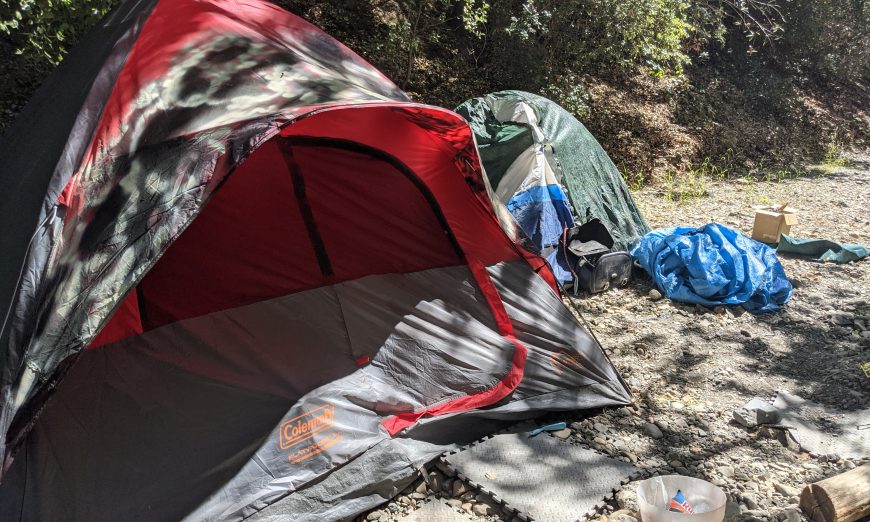Whether it’s switching a children’s musical theater camp to Zoom on the fly, or a fire in a homeless encampment 10 feet from her fence, VanNessa Hulme Silbermann has never met a challenge she wasn’t ready to tackle head-on.
The musician and teacher, who with her husband operates a music studio in their home, became aware of the homeless encampment in Saratoga Creek* behind their Cascade Park neighborhood home shortly after moving in. It helped that she had previous experience working with homeless people in Los Angeles.
“There’s too much bureaucracy,” she said. “Too many people trying to solve the problem who have never walked down that creek. It’s not such an overwhelming problem that it can’t be solved.”
So, where others’ response might be to demand those bureaucracies “do something” about it, Silbermann walked the creek, met the people living there and began finding ways to provide some immediate help and clean up the hazards and unsanitary condition of the creek.
She connected with the grass roots service group Helping Hands Silicon Valley and started organizing visits to the creek encampments, providing food, clothing, medical care and connecting homeless people with social services. She got her neighbors and her Council Member, Anthony Becker, involved. Now there’s a group of about 50 that meet once a month.
“Everyone in the neighborhood wants to solve this problem,” she said. “They want to help these people.
She got to know City police officers, County and Water Department officials. She organized a neighborhood group to send emails, make calls, identify the encampments and work with public agencies to address the problem.
“All of them have been very responsive,” she said. The challenge is that there’s little coordination among agencies, services are overly specific in what they do or whom they serve, and there’s not much in the way of a strategic plan.
For example, the Santa Clara Valley Water District (http://www.valleywater.org) is responsible for Saratoga Creek, but the City is responsible for the areas under bridges.
Santa Clara resident Tony Tran illustrated the confusion. “There’s a homeless encampment next to my house. When the PD arrives they say the water district is responsible.”
Although the group was able to help some of those living in the creek bed to move, many are still homeless and now camped in other parts of Santa Clara.
“It’s not a lack of compassion,” said one resident voicing her frustration with the confusion of agencies and responsibilities when she tried to find help for a homeless man sleeping on her front doorstep. “It’s a safety issue.”
From Compassion to Action
The neighborhood group grew to about 30 people, and last Monday the group held what was likely Santa Clara’s first homelessness town hall. Santa Clara Mayor Lisa Gillmor, Council Member Becker, Santa Clara Police Department and the County Water District were on hand to answer questions.
Santa Clara is getting organized with a strategy to stop the homelessness ‘musical chairs,’ said Gillmor. First, urgent situations and conditions can be reported to the City via the MySantaClara mobile app (santaclaraca.gov/mysantaclara).
“It’s funneled to the right department,” she said, “and they’ll track it and report back to you.
“We’re now expanding the former Housing Rehabilitation Loan Committee into a City housing commission,” she continued. “It will be formally created on Aug. 24, and will work with the County Task Force on Homelessness. Council Member Suds Jain will be creating a task force on homelessness. We will be moving forward quickly on that.”
Gillmor also reminded people that the City has $2.8 million budgeted for emergency rental assistance to help people at risk of homelessness, and has signed a contract with the County to deliver services for homeless people in Santa Clara. Four hundred new affordable housing units are under construction in Santa Clara, 100 of them will be supported living.
In the past year Santa Clara has made progress reducing youth homelessness, added Becker, with the new Covenant House transitional living center for teens and young adults.
Santa Clara PD has rechristened the nuisance suppression unit the Community Response Team and added new Crisis Intervention Specialists like RJ Otico, taking a new approach dealing with mental illness and people in crisis. This starts with Otico asking people to call him “RJ” instead of “officer,” and his cargo pants, sweatshirt and sneakers ‘uniform.’
“I make it a point to go out there and connect with people,” Otico said. “The vast majority of homeless have some kind of mental illness. We will enforce the law, but we can’t force anyone into treatment. It’s just important for people to know that help is being offered. ‘Heavy’ enforcement is not a very productive model.”
Otico also stressed that in order to cite someone for trespassing, people must be willing to sign their names to a complaint — something many are reluctant to do. Above all, people should communicate with the police and public agencies. “We need to know what’s going on,” he said.
As proof of his commitment, Otica promised immediate personal visits to the two homeowners that spoke up about their personal frustrations with homeless encampments on their doorsteps.
SCPD’s homelessness response website, SantaClaraCA.gov/HomelessResponse, provides information and resources for residents and to help the homeless. The Santa Clara City Council will hold a homelessness study session at its Aug. 24 meeting.
Despite the appearance that homelessness is an intractable problem, some towns in the U.S. have ended chronic homeless with Built for Zero (BuiltforZero.org). The nonprofit’s 360-degree method starts by getting to know the people who are homeless by name and their individual needs.
*Saratoga Creek runs through Santa Clara Central Park.






